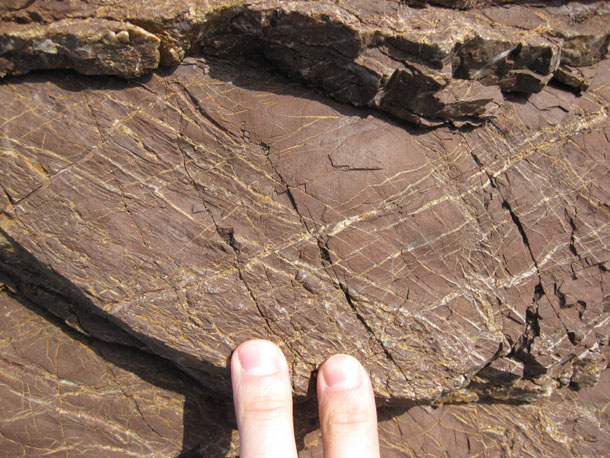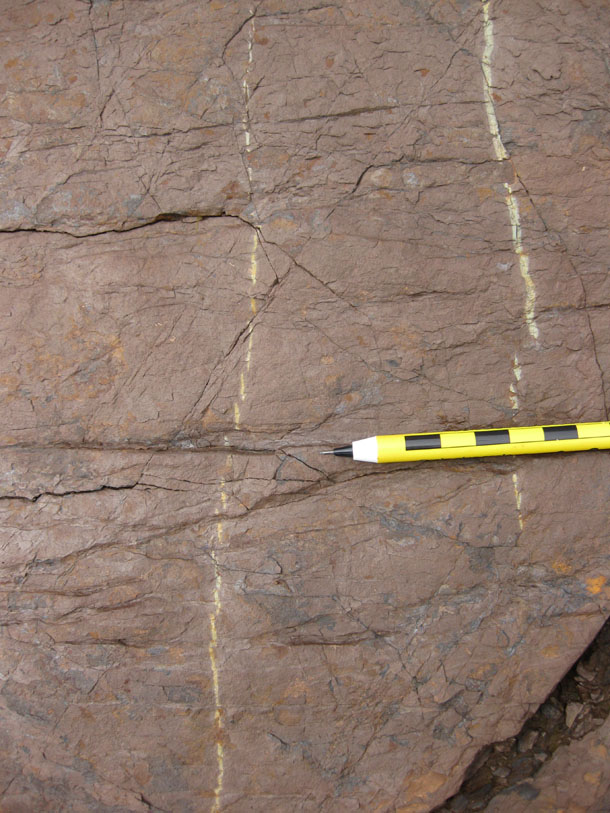“GoSF” = Geology of San Francisco
Post-holiday depression? Nothing like some brittle deformation to cure that! In case you’re only now pulling your head out of that coal-filled stocking, Mountain Beltway is reviewing three field trips I took last week examining the geology of San Francisco and neighboring areas. The master plan is to cover:
Fractures and the chemistry along them (today)
Pleistocene dunes
The San Andreas Fault and Mussel Rock
The chert we looked at on our second & third parts of this series is distinguished by its ductile deformation (those lovely folds), but it also exhibits some brittle deformation. The chert layers act as big slabs between the layers of shale above and below them, and they frequently exhibit cracks that run across the chert “plate”. Like last Tuesday and Wednesday, I showed you the two folds re-displayed below, and you can see the fractures which run orthogonal (perpendicular) to the plane of bedding in the chert, showing extension along the fold’s hinge.


If we swivel our perspective around so that we are looking down on the chert bedding plane, we can see those fractures have a variety of orientations:


Sometimes, the fractures open up a bit, permitting fluids to flow along them. These fluids may deposit minerals like quartz which seal shut the fracture as glue would seal shut the fractures in a broken dinner plate:

These look to me like conjugate pairs of fractures, with sigma one (maximum principal stress) being oriented left-to-right for these photos. The angle of the fractures (acute ~60°; obtuse ~120°) suggests this… Anyone else who knows more about fracturing than me want to chime in?


Closer in to the previous photo:

Walking down the road in Marin Headlands on our way back to the Golden Gate Bridge, I thought I spied some offset veins in a chert layer at the roadside:

But when I got up and took a closer look, I found something even more interesting:

These aren’t “veins” at all — but simply reduced zones along fractures in the oxidized (red) chert. The en echelon pattern suggests that we are looking at a small tension gash array, or perhaps the hackle fringe at the edge of a larger joint.

The whole oxidation/reduction issue prompts me to show you this image, which is looking down on a single bedding plane of chert, a bed which has been altered presumably sometime after its deposition by reducing fluids. The original chert is reddish presumably because it includes windblown dust from a continental source. Later, reduction reactions take place — sometimes as point sources (like in reduction spots), and sometimes along fractures (as above), and sometimes in more chaotic, “blobby” patterns, like here:

Finally, along similar “chemical alteration via fracture” lines: I saw something cool at Baker’s Beach, which looked to me an awful lot like the “pillows” that Lukert & Mitra (1986) reported from Virginia’s Catoctin Formation in Shenandoah National Park. You’ll recall (a) that Baker’s Beach hosts outcrops of graywacke, not pillow basalt, and (b) that I interpreted the Catoctin structures as (1) alteration of the host rock along a criss-crossing fracture network followed by (2) differential weathering of altered and unaltered host rock. Take a look at the Baker’s Beach outcrop and see if you see what I see:

Looks like the same pattern to me. Compare with these examples from the Catoctin, or this example of “boxwork” on display in the USGS library in Reston, Virginia.
Home stretch, people — only two more episodes of GoSF to go!

Nice fracturing and ‘regluing’ and several cycles from different directions.
I think that this is evidence that the ‘Kariong/Gosford rock posed as ancient archaeological scratchings in wakeup-world website is actually chert geology.
Many thanks.